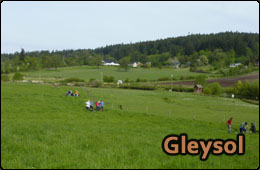Soil Site Details: Fort Langley Gleysol
Soils on this site are Gleysols. These mineral soils are saturated for a prolonged period of time due to a high water table. This results in bluish-grey mottling in the soil profile, called gleying. The name Gleysol originated from the Russian word gley meaning mucky soil mass.
Basic Facts
Soil Order: Gleysol
Ecosystem: Mixed Forest
Climate Zone: Humid Maritime
BC Biogeoclimatic Zone: Coastal Western Hemlock
Location: Fort Langley
City, Region, Country: Lower Fraser Valley, British Columbia, Canada
Lat / Long: 49.16528/ -122.57
Soil Order: Gleysol
Great Group: Humic Gleysol
Subgroup: Orthic Humic Gleysol
Soil Series: Hazelwood
Classification Code: O.HG
Soil Horizons Present: Ap, Bg, Cg
Diagnostic Horizon 1: Bg
Diagnostic Horizon 2:
Diagnostic Horizon 3:
Diagnostic Horizon 4:
Land Form: Fluvial
Parent Material: Fluvial
Elevation (m): 7
Topography: Level
Affected by Glaciation: Yes
Climate Zone: Humid maritime
Mean Annual Temperature (C): 10
Minimum Annual Temperature (C): 6.5
Maximum Annual Temperature (C): 13.7
Mean Annual Precipitation (mm): 1200
Current Land Use: Agricultural, cultivated field
Original Vegetation: Black cottonwood, vine maple, willow, salmonberry, blackberry, red alder, Douglas-fir, western hemlock, western red cedar
Current Vegetation: Annual agricultural crops (vegetables, small fruits)
rainfall.
PDF with details: 10_Hazlewood.pdf
Soil texture horizons: Silt loam (Ap), Silty clay loam (Bg)
Soil structure horizons: Fine granular (Ap), Angular blocky (Bg)
Forest Humus Form:
Presence of Charcoal:
Presence of Coatings:
Primary Soil Process: Gleying
Secondary Soil Process: Translocation
Links
Resources home: Principles, Land use, awareness, etc.
Processes: Gleysol
Classification: Gleysol
Virtual soil monoliths: via the left-side expanding menu.
Media

Gleysol, from https://processes.soilweb.ca/gleysol/.
Featured Expert: Dr. Christine Cross
Video host: Dr. Art Bomke